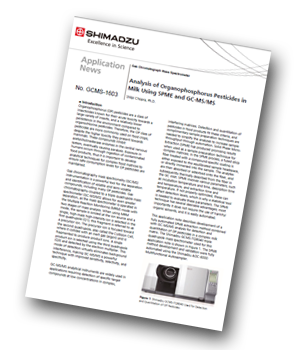Shimadzu has produced an application note describing the development of a fully automated SPME extraction method combined with GC-MS/MS analysis for detection and quantitation of organophosphorus (OP) pesticides in a complex milk matrix.
 Introduction
Introduction
OP pesticides are a class of insecticides known for their acute toxicity towards a large variety of insects, and a relatively lower persistence in the environment compared to organochlorine pesticides. Therefore, the OP class of pesticides are more commonly used on food crops, despite the higher toxicity they present towards mammals. These compounds inhibit acetylcholinesterase enzymes in the central nervous system, eventually causing paralysis. Exposure in humans occurs through ingestion of contaminated food products, thus it is important to develop analytical techniques for complex food matrices to ensure safe consumption levels for OP pesticides are maintained.
Experimental
The Shimadzu GCMS-TQ8040 triple quadrupole mass spectrometer was used for this application note. The SPME method development and validation were fully automated using the Shimadzu AOC-6000 Multifunctional Autosampler. The Shimadzu Smart Pesticide Database was used as the foundation for creating the MRM analysis method. The Smart Pesticide Database includes up to six fully optimized MRM transitions and collision energies (CEs) for 479 pesticides and Retention Indices (RI) for accurately predicting compound retention times.
Conclusion
A method based on HS-SPME, presented here for the analysis of organophosphorus pesticides in milk, was developed using a fully automated AOC-6000 Autosampler. SPME- GC-MS/MS in multiple reaction monitoring (MRM) mode was used for the trace analysis of pesticides in milk. The method was calibrated from 20 μg/L to 1000 μg/L, and all validation statistics were within an acceptable range. This is attributed to effective extraction using automated SPME that ensures precision by eliminating analysis variables in sample preparation and MS-MS, which allows monitoring of transitions specific to each pesticide, delivering high selectivity and resulting low noise.




